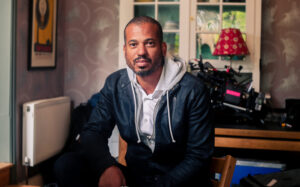Driving Change: Unifying Digital/Physical
 From Patrick Bennett Executive Creative Director, NY, Momentum Worldwide
From Patrick Bennett Executive Creative Director, NY, Momentum Worldwide
The world is changing. And that’s great. Not just embracing that change but also taking an active role in shaping it is the path toward new models of meaningful consumer engagement.
Cast your mind back to the late 2010s when everyone was buzzing about the experience economy; the rallying cry was that new consumers didn’t want to spend money on things. Not when what they craved were experiences. It was an excellent time to be at an experience agency.
We all know what happened next. The pandemic crashed onto the stage, sending us all scurrying to our living rooms and home offices. The result was that we suddenly really wanted all those things we’d been shunning. Furniture, stationary bikes, TVs, cooking supplies—yes, please! But perhaps more importantly, all those experiences we’d been enjoying went online.
Momentum was well positioned not just to embrace this accelerated change but also to help shape it. Thanks to a strategic investment in technology, the agency was well on the evolutionary path from being an event marketer to being adept at scaled experiences.
A great example of this rapid transition is the difference between the 2020 vs. 2021 Super Bowl activations that Momentum created for Verizon.
In 2020, it was the 5G Stadium. This activation saw thousands of fans through its footprint and drove billions of media impressions. Diego Scotti, Verizon’s CMO, even called it “The most successful Super Bowl activation in Verizon history.”
In 2021, it was Fortnite Stadium. This activation didn’t see thousands; it saw tens of millions of fans through its footprint in the metaverse. And those fans stayed longer, engaged more deeply, and felt more positively about the brand. It even trumped the previous year’s billions of media impressions—by over a billion more.
But trying to pin the pendulum in a purely digital place would be a mistake. Now, in 2023, consumers are living with permanent crises, all those things we desired in 2020 are now more expensive than ever, and on top of everything else, consumers are drowning in digital. Needing to scan a QR code just to order lunch, juggling Zoom parent-teacher conferences, being inundated with pings from needy communication apps—it’s a lot to take. Over a third of the consumers report feeling overwhelmed managing the tech in their lives.
Another knee-jerk reaction might be to go purely physical as a remedy, but that time has passed. Our digital lives are now so thoroughly woven into our physical lives that there’s no longer a distinction. And how we connect with consumers should reflect this reality while being considerate and not overloading people.
When it comes to digital and physical, it’s not either-or; it’s and.
By blending physical and digital experiences, we can deliver incredible results for marketers. Digital brings the ability to reach and engage hundreds of millions. At the same time, physical brings meaningful connections, deeper engagement, and brand metrics that are to die for. Blending them offers a chance to reap the rewards of both approaches.
Again, Momentum finds itself well positioned to maximize this trend, given that we coined the term “phygital” all the way back in 2007.
But continuing to evolve into this new consumer reality, and whatever the next may be, takes a multi-pronged approach.
First, brands and marketers need to remain in culture—taking advantage of trends as they appear to drive richer connections.
Trends like “newstalgia” which leans into consumers’ desire to experience a pre-digital-swathed life. “Dumb” digital products like early 2000s cameras, flip phones, and the resurgence of music lost to modern culture like Kate Bush’s Running up That Hill—all of these cultural movements and more under the umbrella of “newstalgia” are fun areas to play for marketers.
But surfing culture is only part of the puzzle. When I see brands blindly chasing culture, I always remember what an editor at a prominent women’s fashion magazine bluntly declared to me years ago when I asked her how she knew what would be on trend a year from now. She said, “I make the trends.”
When your strategy is simply riding trends, then you and the brands you partner with can only ever be one of many. And when you don’t stand out, you’re easily forgotten.
Therefore, another part of the strategy must include consistently deploying creativity to push boundaries and attempting to remix culture into new and novel creations. At Momentum, we’re using this approach to create unique and differentiated offerings.
And to be well-positioned for what could be coming next, it takes deploying a robust test-and-learn practice founded on data. Historically, data and the experiential realm haven’t always been the closest of friends. But investing heavily in return on experience data allows us to quantify the success of big creative bets and systematically build off those successes.
Ultimately, at Momentum, we’re erasing the line between digital and physical while marrying creativity and data to not just keep our agency up on the latest trends but to create them. Making it an excellent time to be at an experience agency.
_________
Patrick shapes Momentum’s creative vision for Walmart, Verizon, American Express, Corona, and Pacifico, among other brands. Caribbean travel and culture are his first loves.
